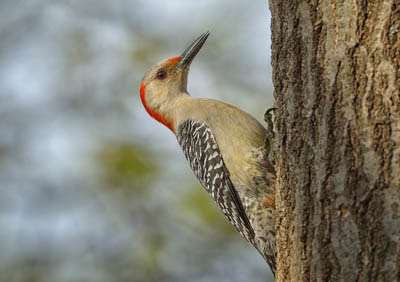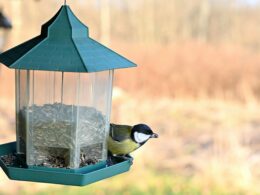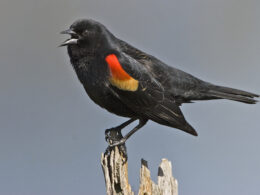Last Updated on January 26, 2024 by Greg Gillson
Red-bellied Woodpeckers are medium-sized woodpeckers. They are common in woodlands in the eastern United States.
They readily come to feeders if you live near big trees and provide the right foods.
How do you attract Red-bellied Woodpeckers to your feeder? Follow these suggestions to attract Red-bellied Woodpeckers to your yard.
 |
| Red-bellied Woodpecker. Skeeze. Pixabay. |
Why attract Red-bellied Woodpeckers to your bird feeder?
Woodpeckers, in general, are very interesting to watch. They behave so much differently than other birds. They spend most of their life hitching up the trunk of trees, probing and digging in the bark for insects.
They can be loud, too. So, you’ll always know when they are at your feeder!
Red-bellied Woodpeckers have adapted to live in city residential areas and parks. Thus, they are rather easy to attract to your backyard bird feeder if you have larger trees nearby.
The coloration of Red-bellied Woodpeckers in unique. They have finely barred black-and-white back, wings, and tail feathers. The extent of the red crown helps you tell males from females.
These birds aren’t very aggressive toward other birds. They occur singly or in pairs. Thus, they don’t overwhelm the bird feeder in numbers or action.
For these reasons Red-bellied Woodpeckers are welcome at feeders across the East.
 |
| ryanacandee. Flickr. CC-BY-2.0 |
What foods will attract Red-bellied Woodpeckers to your feeder?
To attract Red-bellied Woodpeckers, feed them suet in winter. This fat provides them calories and protein like their natural food–grubs!
Speaking of grubs, Red-bellied Woodpeckers love mealworms, both live and dried. I recently tried feeding birds mealworms. Read the article here.
For my home feeders, I always purchase St Albans Bay Suet blocks. It comes in several flavors, including peanut and berry. They fit in required special suet cages, which are a type of bird feeder.
These woodpeckers love peanuts and tree nuts. Feed them nuts removed from the shell. They may like nut pieces or halves. For birds, nuts should be fed raw and unsalted.
Red-bellied Woodpeckers may also eat sunflower seeds, both striped sunflowers and black oil sunflowers. They will eat them whole or shelled.
The best mixed bird seed that I have found is Wagner’s Songbird Supreme. It is 50% sunflower seeds and doesn’t have any cheap filler seed that birds won’t eat. This seed attracts the largest variety of birds to your feeder. Woodpeckers will eat the sunflower seeds and peanut pieces and leave the other smaller seeds for the sparrows.
As an alternative to bird seed, Red-bellied Woodpeckers will like seed blocks. They may be called quail blocks or wildlife blocks. Check the label to make sure it lists sunflowers and peanuts as one of the first 3 ingredients.
Red-bellied Woodpeckers may also eat fruit. Try serving sliced oranges, apples, and grapes.
They also drink nectar from hummingbird feeders. That can be a good thing or a bad thing, as I’ll discuss toward the end of this article.
 |
| Ian Lee. Flickr. CC-BY-2.0 |
What kind of feeders do Red-bellied Woodpeckers like?
Red-bellied Woodpeckers prefer to eat from platform feeders and larger hopper feeders. These give them room to eat, as they are a bit larger than many of the other birds at the feeder.
As for a suet feeder, they’ll eat from any.
I bought a Nature’s Way Upside-down suet feeder a couple years ago and have been very happy with it. Chickadees, nuthatches, bushtits, and woodpeckers eat from it easily. But starlings, blackbirds, and jays can’t hang upside down to get at the suet.
Where to place your bird feeder for Red-bellied Woodpeckers
Red-bellied Woodpeckers aren’t overly timid. They will come to feeders near the home, but probably not if you are outside and near the feeders. They are large enough they hold their own against other birds.
You may want to separate different feeders from each other, based on food type. That way the different species of birds, which like different foods, aren’t in competition.
Consider placing your suet feeder near a large tree. That’s where the Red-bellied Woodpecker will probably approach from.
 |
| Kim Taylor Hull. Flickr. CC-BY-2.0 |
How else can you attract Red-bellied Woodpeckers to your yard?
As long as it is safe, consider leaving standing dead trees that serve as a home for wildlife. Woodpeckers will drill nest holes into such trees. Then, in subsequent years, other cavity nesting birds will use the old woodpecker holes for their nest.
You may plant or encourage trees with berries. Red-bellied Woodpeckers and other birds will eat the fruit of hawthorn, mountain ash and elderberries.
Red-bellied Woodpeckers will appreciate a bird bath with clean water for drinking and bathing.
Red-bellied Woodpeckers are one of the few woodpeckers that will nest in a man-made nest box. The dimensions should be 17-1/2 x 7-1/2 x 9-3/4 inches. The entrance hole should have a diameter of 2-1/4 inches, and be protected with a metal predator guard to prevent the woodpecker from making the hole bigger. This is larger than the typical bluebird nest boxes. Place the nest box 8-20 feet high in a tree.

Problems with Red-bellied Woodpeckers: If you have attracted too many to your feeder
Red-bellied Woodpeckers are usually not a nuisance. But they can be loud, sometimes.
But any woodpecker may drill holes in your siding or drum on your house or downspouts to declare their territory. This is usually only a problem in spring. If it happens at other times of year, have your home inspected for termites.
I have used reflective bird tape with success to discourage similar Gila Woodpeckers from excavating nest holes in the siding of my house. They nest in the saguaro in my yard, but drill holes in spring in places they shouldn’t. I cut strips about 16 inches long and attached them to my eves with thumbtacks near where they were drilling. Easy and cheap.
Red-bellied Woodpeckers are a bit too big to eat from tube feeders. But they try! And they can damage or destroy such feeders trying to get inside. Here’s a great tube feeder that discourages woodpeckers. It has metal top and feeding ports to protect against damage from woodpeckers and squirrels.
I really love the way my iBorn tube feeder looks, with it’s copper top. A screwdriver takes off the lower perch and opens it up for cleaning. This feeder filled with black oil sunflower seeds attracts all types of finches, chickadees, and nuthatches. The smaller perches and lack of tray mean that you’ll have fewer House Sparrows, Starlings, Doves, and Jays at this feeder.
Wrapping Up
The Red-bellied Woodpecker stands out among its woodpecker brethren! While they share some common features like strong bills and drumming habits, the Red-bellied Woodpecker does have some distinct characteristics that set it apart. Here’s why it might appear different:
1. Head Coloration:
- Many woodpeckers like the Hairy and Downy Woodpecker sport striking black and white head patterns. In contrast, the Red-bellied Woodpecker has a red patch on its head and neck, sometimes described as “capped” rather than fully patterned. This red coloration is more prominent in males, while females might show less intense or even faint red patches.
2. Belly Markings:
- The name “Red-bellied” might be misleading as the red plumage on its belly is often subtle and difficult to see, especially when the bird is clinging to a tree trunk. This differs from woodpeckers like the Red-headed Woodpecker that clearly display vibrant red plumage on their heads and bodies.
3. Overall Size and Pattern:
- The Red-bellied Woodpecker is larger than the Downy and Hairy Woodpeckers, closer in size to the Northern Flicker. Its plumage boasts barred patterns on its wings, back, and tail, creating a more striped appearance compared to the black and white patches typical of smaller woodpeckers.
4. Habitat Preference:
- While many woodpeckers favor dense forests, the Red-bellied Woodpecker is more adaptable and frequents diverse habitats like woodlands, edges of forests, parks, and even backyards. This wider habitat range might make encountering them different from woodpeckers typically associated with deeper woods.
5. Drumming Sound:
- The Red-bellied Woodpecker’s drumming might have a slightly lower-pitched quality compared to the rapid drumming of smaller woodpecker species. This difference can be a subtle clue for experienced birders familiar with the distinct drumming sounds of various woodpeckers.
Remember:
- Despite these differences, the Red-bellied Woodpecker still shares key woodpecker characteristics like its strong bill, climbing abilities, and use of drumming for communication and foraging.
- Observing their behavior and paying attention to specific details like size, plumage patterns, and vocalizations can help you confidently identify them and appreciate their unique characteristics within the woodpecker family.
Frequently Asked Questions
How rare is a Red-bellied Woodpecker?
Red-bellied Woodpeckers are not considered rare birds. In fact, they are widespread and common across much of eastern and central North America. Their population is estimated to be around 16 million, and they are classified as a species of low conservation concern by Partners in Flight.
Here’s a breakdown of their abundance and factors influencing your chances of seeing one:
Range and Abundance:
- Found in various habitats like mature forests, woodlands, parks, and even backyards across eastern and central North America.
- Their population has been increasing in recent decades due to their adaptability and ability to thrive in human-modified landscapes.
What does a female Red-bellied Woodpecker look like?
Female Red-bellied Woodpeckers are striking birds, though they differ slightly in appearance from their male counterparts. Here’s a breakdown of their key features:
Overall Size and Shape:
- Similar in size to male Red-bellied Woodpeckers, measuring around 9-10.5 inches in length with a wingspan of 15-18 inches.
- Medium-sized woodpecker with a sturdy body, strong bill, and distinctive undulating flight pattern.
Head and Neck:
- Red patch: Instead of the full red “cap” seen on males, females have a patch of red confined to the back of the neck. This red patch might be small and faint, especially in younger females.
- Black and white patterning: Similar to males, they have a black and white striped forehead and crown, contrasting with the red neck patch.
Underparts:
- Pale gray to cream-colored feathers on the belly and chest.
- The namesake “red belly” is often difficult to see, even in good light. It manifests as a faint reddish blush or wash on the lower abdomen, making identification based solely on this feature challenging.
What are Red-bellied Woodpecker enemies?
Like most animals, Red-bellied Woodpeckers face various threats and predators at different stages of their lives. Here’s a breakdown of their potential enemies:
Predators of Adults:
- Aerial predators:
- Birds of prey like Sharp-shinned Hawks, Cooper’s Hawks, and Northern Goshawks can snatch them in mid-flight, especially in open areas.
- Falcons like American Kestrels and Peregrine Falcons can be swift predators, catching them on the wing.
- Owls like Great Horned Owls and Eastern Screech Owls are skilled nighttime hunters and might catch them while roosting.
- Ground predators:
- Domestic cats roaming outdoors pose a significant threat to Red-bellied Woodpeckers and other small birds, especially near houses and feeders.
- Snakes like Black Rat Snakes and Eastern Rat Snakes can climb trees and consume eggs or nestlings.
- Other mammals like weasels, martens, and foxes can occasionally prey on them, although their impact is generally less significant than cats or snakes.
Nest Predators:
- Birds:
- Other woodpecker species like Pileated Woodpeckers and European Starlings sometimes compete for nest cavities and might damage or take over Red-bellied Woodpecker nests.
- Crows and jays might raid nests for eggs or nestlings.
- Snakes: As mentioned above, snakes can climb trees and prey on eggs and nestlings.
- Mammals: Squirrel species like gray squirrels and eastern fox squirrels can also raid nests, although their impact is less frequent than snakes.
Related:
Why aren’t birds coming to your feeder?
First in series: Irresistible! Attract Mourning Doves to your feeder










